It looks like you're using an Ad Blocker.
Please white-list or disable AboveTopSecret.com in your ad-blocking tool.
Thank you.
Some features of ATS will be disabled while you continue to use an ad-blocker.
share:
It's unbelievable what imaginative, unique creatures are to be found at the ocean floor!
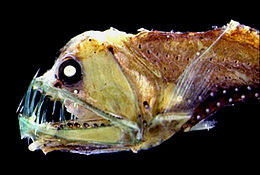
The Sloane's viperfish can make nightly migrations from bathypelagic depths to near surface waters.
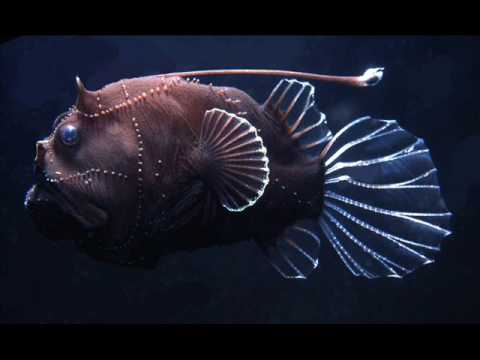
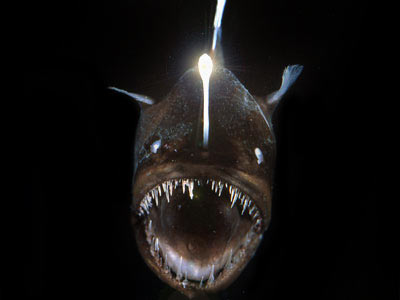
Anglerfish are bony fish named for their characteristic mode of predation, in which a fleshy growth from the fish's head acts as a lure. Anglerfish occur worldwide. Some are pelagic (dwelling away from the sea floor), while others are benthic (dwelling close to the sea floor); some live in the deep sea, while others on the continental shelf. Pelagic forms are most laterally compressed, whereas the benthic forms are often extremely dorsoventrally compressed (depressed), often with large upward-pointing mouths.
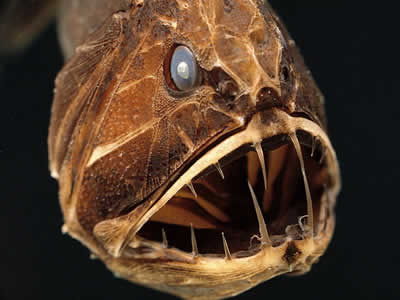
Fangtooths are beryciform fish of the family Anoplogastridae (sometimes spelled "Anoplogasteridae") that live in the deep sea. The name is from Greek anoplo meaning "unarmed" and gaster meaning "stomach".
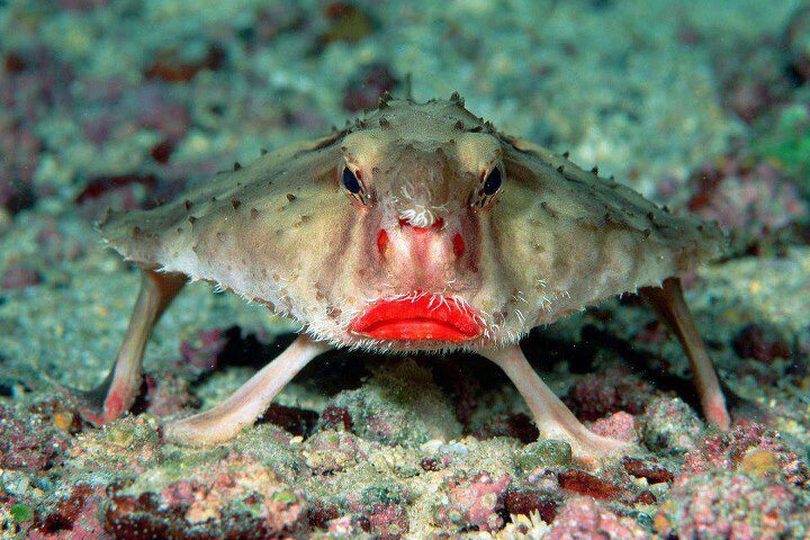
Red-lipped batfish are closely related to rosy-lipped batfish, which are found near Cocos Island off the Pacific coast of Costa Rica. This fish is mainly known for its bright red lips. Batfish are not good swimmers; they use their highly adapted pectoral fins to "walk" on the ocean floor. When the batfish reaches maturity, its dorsal fin becomes a single spine-like projection (thought to function primarily as a lure for prey). Like other anglerfish, the red-lipped batfish has a structure on its head known as illicium. This structure is employed for attracting prey.
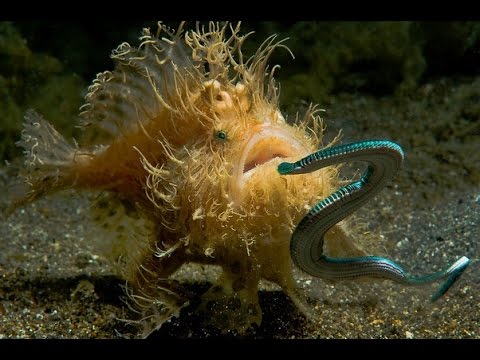
The striated frogfish or hairy frogfish is a small fish that grows up to 22 cm (8.7 in) long. Like other members of its family, it has a rounded, extensible body, and its soft skin is covered with irregularly-arranged dermal spinules resembling hairs. Its large mouth is forwardly extensible, allowing it to swallow prey as large as itself. The coloring of its body is extremely variable because individual fish tend to match their living environments. Frogfishes have the capacity to change coloration and pigment pattern, taking only a few weeks to adapt.
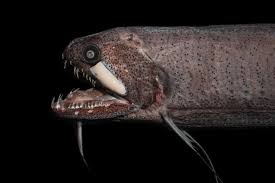
The black dragonfish is a barbeled dragonfish found in southern subtropical and temperate oceans between latitudes 25°S and 60°E, at depths down to 2,000 metres (6,600 ft). The species is sexually dimorphic: females are black with six stripes; male are brown, and lack the females' canine teeth, pelvic fins and barbel. Females are believed to make a diel vertical migration from deeper than 500 metres (1,600 ft) by day to surface waters at night, whereas males do not migrate, remaining below 1,000 metres (3,300 ft) at all times.
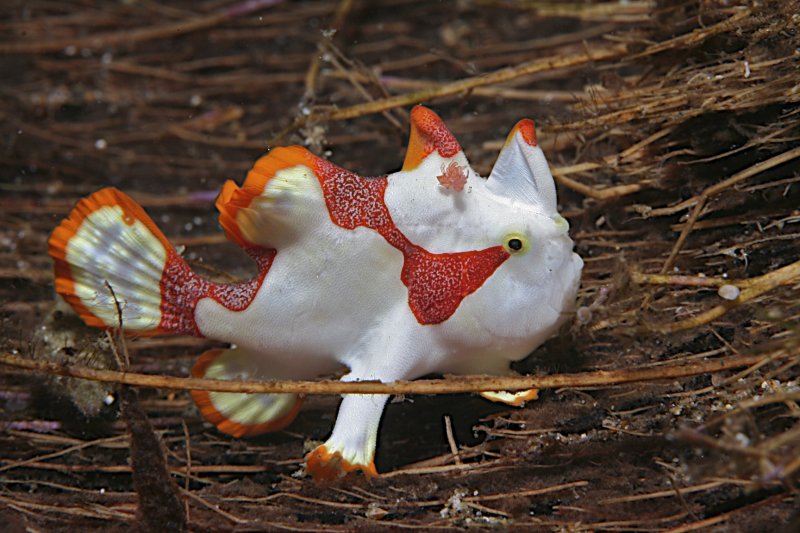
The warty frogfish grows up to 15 cm (5.9 in) long. Like other members of its family, it has a globulous, extensible body, and its soft skin is covered with small dermal spinules. The skin is covered with numerous small, wart-like protuberances. Its large prognathous mouth allows it to consume prey its same size. The coloring of its body is extremely variable because it tends to match its living environment.
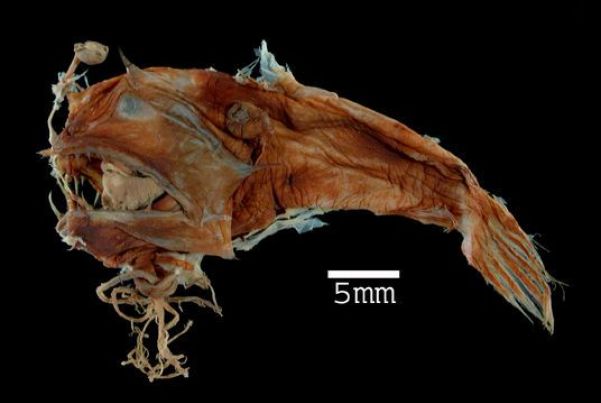
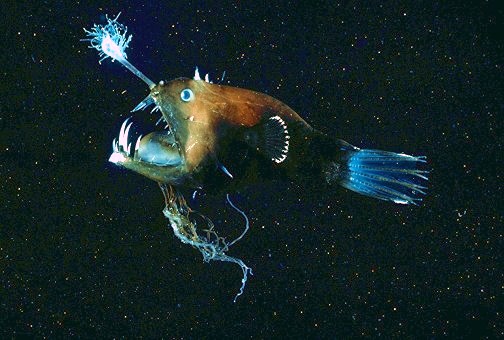
The illuminated netdevil is an anglerfish found in all tropical and subtropical oceans at depths below 1,000 m (3,300 ft) in the Bathyal zone. Its length is up to 77 mm (3 inches). The female is significantly larger than the mature, parasitic male.

The longlure frogfish is a species of frogfish in the genus Antennarius found in the western Atlantic from Bermuda and the Bahamas, south along the coasts of Central and South America, to Brazil around warm shallow reefs with abundant sponge populations at depths less than 215 feet (66 m).
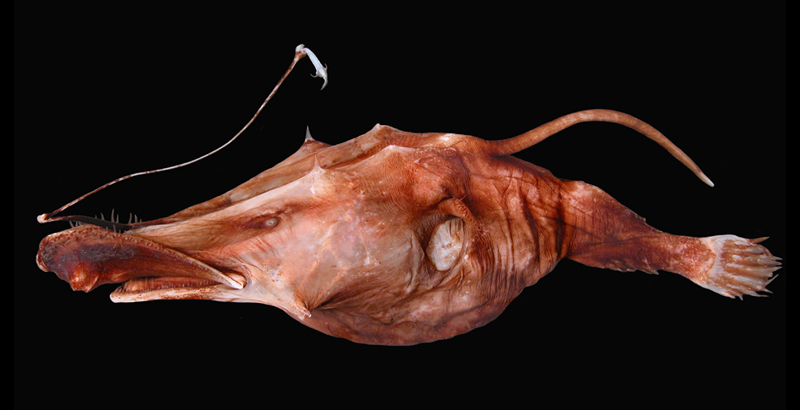
Lasiognathus saccostoma is a species of wolftrap angler known from the eastern central Pacific Ocean and tropical waters of the Atlantic Ocean. It is found at depths to 4,000 metres (13,000 ft). The females of this species grow to a length of 7.7 centimetres (3.0 in) SL. This species has a slender, compressed prolongation at the tip of its elongated, cylindrical distal escal appendage, with numerous lateral serrations and distal filaments. Unlike in L. amphirhamphus, there are three escal hooks and they are darkly pigmented. The posterior escal appendage is broad and laterally compressed, and relatively larger than in L. amphirhamphus.
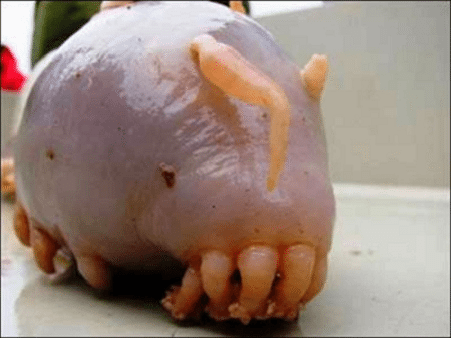
The sea pig is a genus of deep-sea sea cucumbers. They have particularly enlarged tube feet that have taken on a leg-like appearance, and are the only instance of legged locomotion amongst the holothurians, using water cavities within the skin (rather than within the leg itself) to inflate and deflate the appendages.
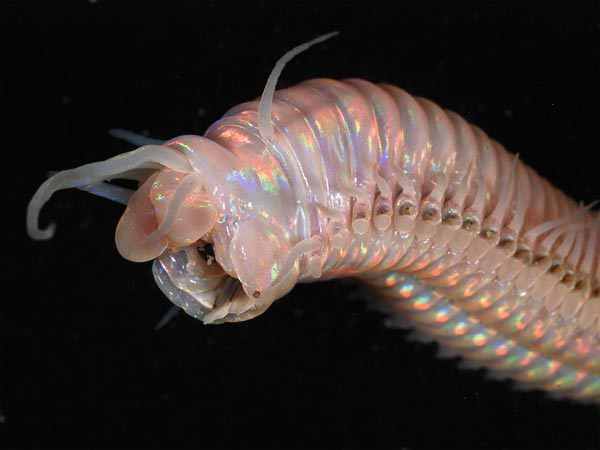
The Polychaeta, also known as the bristle worms or polychaetes, are a paraphyletic class of annelid worms, generally marine. Each body segment has a pair of fleshy protrusions called parapodia that bear many bristles, called chaetae, which are made of chitin. As such, polychaetes are sometimes referred to as bristle worms. More than 10,000 species are described in this class. Common representatives include the lugworm (Arenicola marina) and the sandworm or clam worm Alitta.
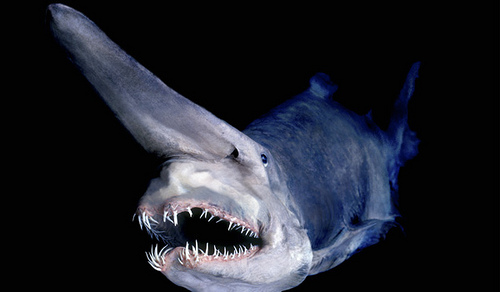
The goblin shark (Mitsukurina owstoni) is a rare species of deep-sea shark. Sometimes called a "living fossil", it is the only extant representative of the family Mitsukurinidae, a lineage some 125 million years old. This pink-skinned animal has a distinctive profile with an elongated, flattened snout, and highly protrusible jaws containing prominent nail-like teeth. It is usually between 3 and 4 m (10 and 13 ft) long when mature, though it can grow considerably larger. Goblin sharks inhabit upper continental slopes, submarine canyons, and seamounts throughout the world at depths greater than 100 m (330 ft), with adults found deeper than juveniles.
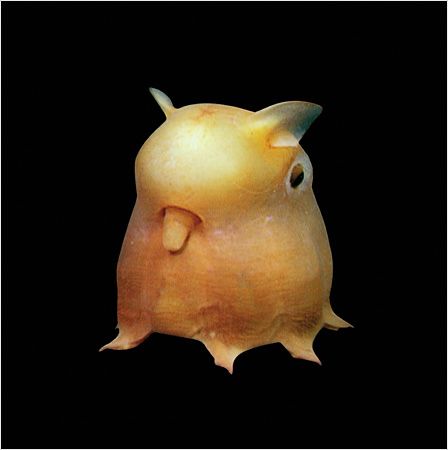
The Dumbo Octopus. The name "dumbo" originates from their resemblance to the title character of Disney's 1941 film Dumbo, having a prominent ear-like fin which extends from the mantle above each eye. There are 13 species recognized in the genus. Prey include crustaceans, bivalves, worms and copepods.The average life span of various Grimpoteuthis species is 3 to 5 years. All species of Grimpoteuthis live at depths of 3,000 to 4,000 metres (9,800 to 13,100 ft) with some living up to 7,000 metres (23,000 ft) below sea level, which is the deepest of any known octopus.
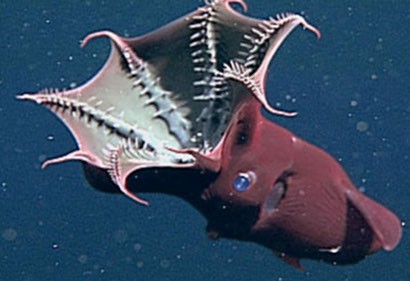
The vampire squid (Vampyroteuthis infernalis, lit. "vampire squid from Hell") is a small cephalopod found throughout temperate and tropical oceans in extreme deep sea conditions. Unique retractile sensory filaments justify the vampire squid's placement in its own order, Vampyromorphida, as it shares similarities with both octopuses and squid. As a phylogenetic relict, it is the only known surviving member of its order.
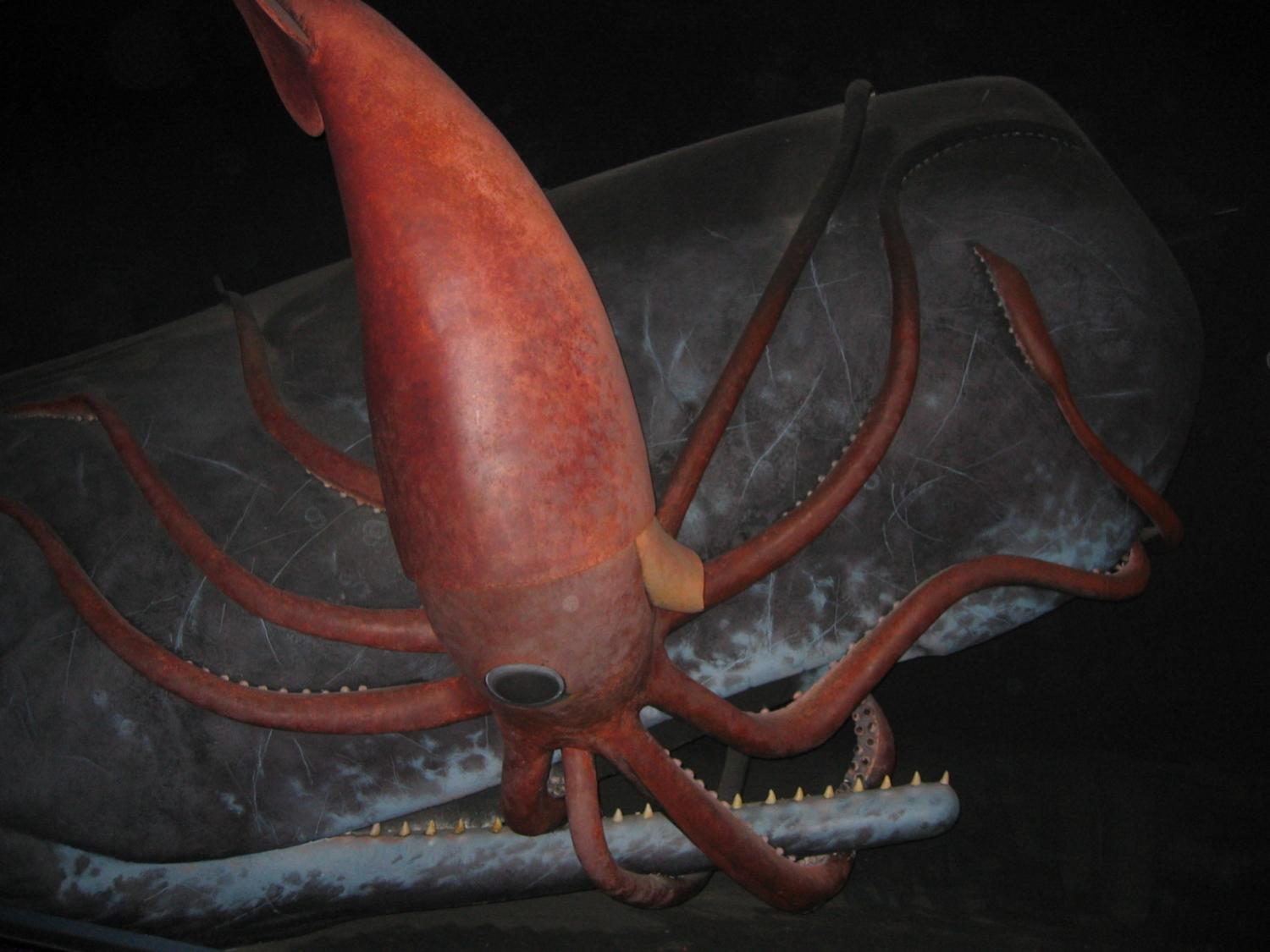
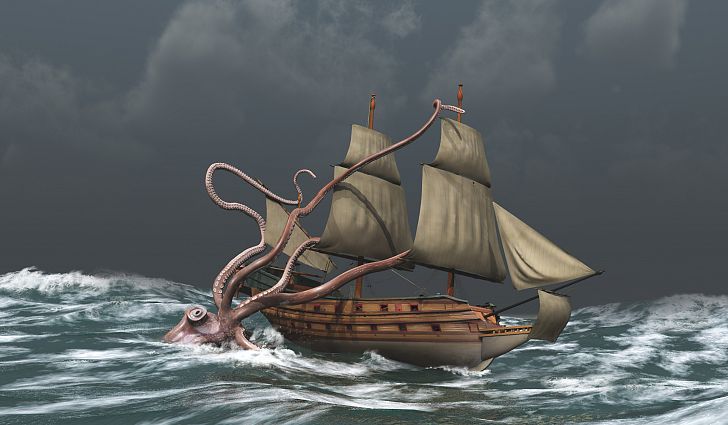
The colossal squid, sometimes called the Antarctic squid or giant cranch squid, is believed to be the largest squid species in terms of mass. It is the only known member of the genus Mesonychoteuthis. It is known from only a few specimens, and current estimates put its maximum size at 12–14 m (39–46 ft) long and weighing possibly up to 750 kilograms (1,650 lb.)

The Sloane's viperfish can make nightly migrations from bathypelagic depths to near surface waters.


Anglerfish are bony fish named for their characteristic mode of predation, in which a fleshy growth from the fish's head acts as a lure. Anglerfish occur worldwide. Some are pelagic (dwelling away from the sea floor), while others are benthic (dwelling close to the sea floor); some live in the deep sea, while others on the continental shelf. Pelagic forms are most laterally compressed, whereas the benthic forms are often extremely dorsoventrally compressed (depressed), often with large upward-pointing mouths.

Fangtooths are beryciform fish of the family Anoplogastridae (sometimes spelled "Anoplogasteridae") that live in the deep sea. The name is from Greek anoplo meaning "unarmed" and gaster meaning "stomach".

Red-lipped batfish are closely related to rosy-lipped batfish, which are found near Cocos Island off the Pacific coast of Costa Rica. This fish is mainly known for its bright red lips. Batfish are not good swimmers; they use their highly adapted pectoral fins to "walk" on the ocean floor. When the batfish reaches maturity, its dorsal fin becomes a single spine-like projection (thought to function primarily as a lure for prey). Like other anglerfish, the red-lipped batfish has a structure on its head known as illicium. This structure is employed for attracting prey.

The striated frogfish or hairy frogfish is a small fish that grows up to 22 cm (8.7 in) long. Like other members of its family, it has a rounded, extensible body, and its soft skin is covered with irregularly-arranged dermal spinules resembling hairs. Its large mouth is forwardly extensible, allowing it to swallow prey as large as itself. The coloring of its body is extremely variable because individual fish tend to match their living environments. Frogfishes have the capacity to change coloration and pigment pattern, taking only a few weeks to adapt.

The black dragonfish is a barbeled dragonfish found in southern subtropical and temperate oceans between latitudes 25°S and 60°E, at depths down to 2,000 metres (6,600 ft). The species is sexually dimorphic: females are black with six stripes; male are brown, and lack the females' canine teeth, pelvic fins and barbel. Females are believed to make a diel vertical migration from deeper than 500 metres (1,600 ft) by day to surface waters at night, whereas males do not migrate, remaining below 1,000 metres (3,300 ft) at all times.

The warty frogfish grows up to 15 cm (5.9 in) long. Like other members of its family, it has a globulous, extensible body, and its soft skin is covered with small dermal spinules. The skin is covered with numerous small, wart-like protuberances. Its large prognathous mouth allows it to consume prey its same size. The coloring of its body is extremely variable because it tends to match its living environment.


The illuminated netdevil is an anglerfish found in all tropical and subtropical oceans at depths below 1,000 m (3,300 ft) in the Bathyal zone. Its length is up to 77 mm (3 inches). The female is significantly larger than the mature, parasitic male.

The longlure frogfish is a species of frogfish in the genus Antennarius found in the western Atlantic from Bermuda and the Bahamas, south along the coasts of Central and South America, to Brazil around warm shallow reefs with abundant sponge populations at depths less than 215 feet (66 m).

Lasiognathus saccostoma is a species of wolftrap angler known from the eastern central Pacific Ocean and tropical waters of the Atlantic Ocean. It is found at depths to 4,000 metres (13,000 ft). The females of this species grow to a length of 7.7 centimetres (3.0 in) SL. This species has a slender, compressed prolongation at the tip of its elongated, cylindrical distal escal appendage, with numerous lateral serrations and distal filaments. Unlike in L. amphirhamphus, there are three escal hooks and they are darkly pigmented. The posterior escal appendage is broad and laterally compressed, and relatively larger than in L. amphirhamphus.

The sea pig is a genus of deep-sea sea cucumbers. They have particularly enlarged tube feet that have taken on a leg-like appearance, and are the only instance of legged locomotion amongst the holothurians, using water cavities within the skin (rather than within the leg itself) to inflate and deflate the appendages.

The Polychaeta, also known as the bristle worms or polychaetes, are a paraphyletic class of annelid worms, generally marine. Each body segment has a pair of fleshy protrusions called parapodia that bear many bristles, called chaetae, which are made of chitin. As such, polychaetes are sometimes referred to as bristle worms. More than 10,000 species are described in this class. Common representatives include the lugworm (Arenicola marina) and the sandworm or clam worm Alitta.

The goblin shark (Mitsukurina owstoni) is a rare species of deep-sea shark. Sometimes called a "living fossil", it is the only extant representative of the family Mitsukurinidae, a lineage some 125 million years old. This pink-skinned animal has a distinctive profile with an elongated, flattened snout, and highly protrusible jaws containing prominent nail-like teeth. It is usually between 3 and 4 m (10 and 13 ft) long when mature, though it can grow considerably larger. Goblin sharks inhabit upper continental slopes, submarine canyons, and seamounts throughout the world at depths greater than 100 m (330 ft), with adults found deeper than juveniles.

The Dumbo Octopus. The name "dumbo" originates from their resemblance to the title character of Disney's 1941 film Dumbo, having a prominent ear-like fin which extends from the mantle above each eye. There are 13 species recognized in the genus. Prey include crustaceans, bivalves, worms and copepods.The average life span of various Grimpoteuthis species is 3 to 5 years. All species of Grimpoteuthis live at depths of 3,000 to 4,000 metres (9,800 to 13,100 ft) with some living up to 7,000 metres (23,000 ft) below sea level, which is the deepest of any known octopus.

The vampire squid (Vampyroteuthis infernalis, lit. "vampire squid from Hell") is a small cephalopod found throughout temperate and tropical oceans in extreme deep sea conditions. Unique retractile sensory filaments justify the vampire squid's placement in its own order, Vampyromorphida, as it shares similarities with both octopuses and squid. As a phylogenetic relict, it is the only known surviving member of its order.


The colossal squid, sometimes called the Antarctic squid or giant cranch squid, is believed to be the largest squid species in terms of mass. It is the only known member of the genus Mesonychoteuthis. It is known from only a few specimens, and current estimates put its maximum size at 12–14 m (39–46 ft) long and weighing possibly up to 750 kilograms (1,650 lb.)
A couple of those were kind of cute, but the rest...looked like some alien creatures from another world. Fascinating! There is so much we don't yet
know about our own planet.
Thanks so much for sharing these, especially during the day!
Wouldn't want to see this before going to bed. LOL!


Thanks so much for sharing these, especially during the day!
Wouldn't want to see this before going to bed. LOL!


thanks for this thread. SOme of these are straight up nightmare fuel. However the one that stood out the most is the Dumbo one. Personally think it
should be called something from Pokemon more than Dumbo
a reply to: LoneCloudHopper2
Here's some more nightmare fuel. An unclassified bigfin squid recorded in 2007 at a Shell Oil drilling site. (thread here)
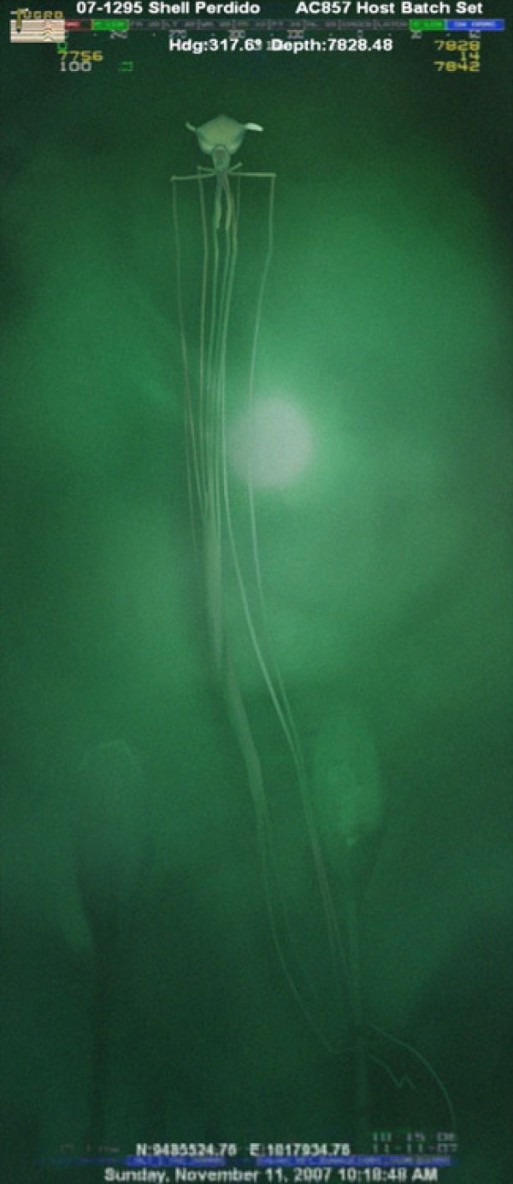
The video is eerie, made no less so by the green hue:
Here's some more nightmare fuel. An unclassified bigfin squid recorded in 2007 at a Shell Oil drilling site. (thread here)

The video is eerie, made no less so by the green hue:
edit on 2018-6-19 by theantediluvian because: (no reason given)
I find the way so many of the deep sea species create their own electricity and beautiful color lights fascinating!!
Plus the see-through types really beautiful.
The amazing thing is we didn't know about any of these a short time ago!
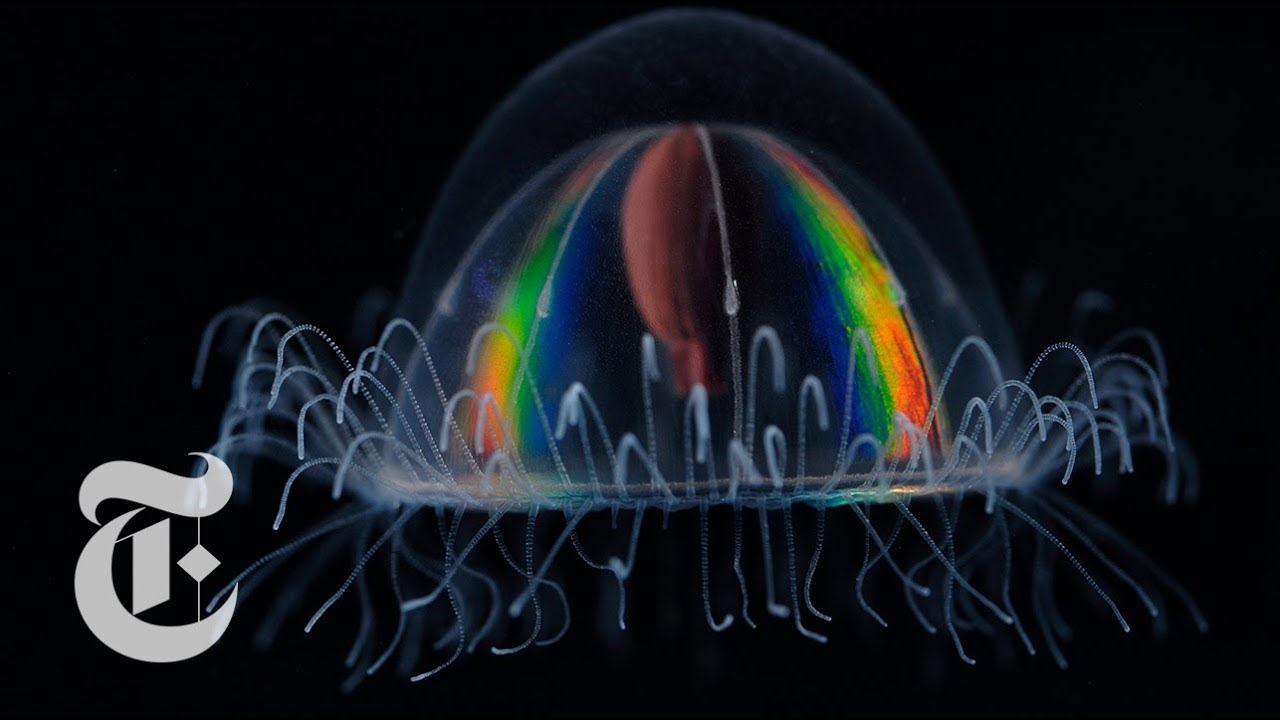
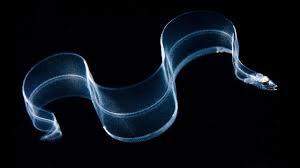
Plus the see-through types really beautiful.
The amazing thing is we didn't know about any of these a short time ago!


edit on 19-6-2018 by SeaWorthy because: (no reason given)
These got them all beat!
The SJW Therapy Fish:

Although it prefers to attack Whitefish & White Bass, in its mind it could beat down a Killer Whale.
Then there's the forums terror from here to Indochina, The Red Herring:
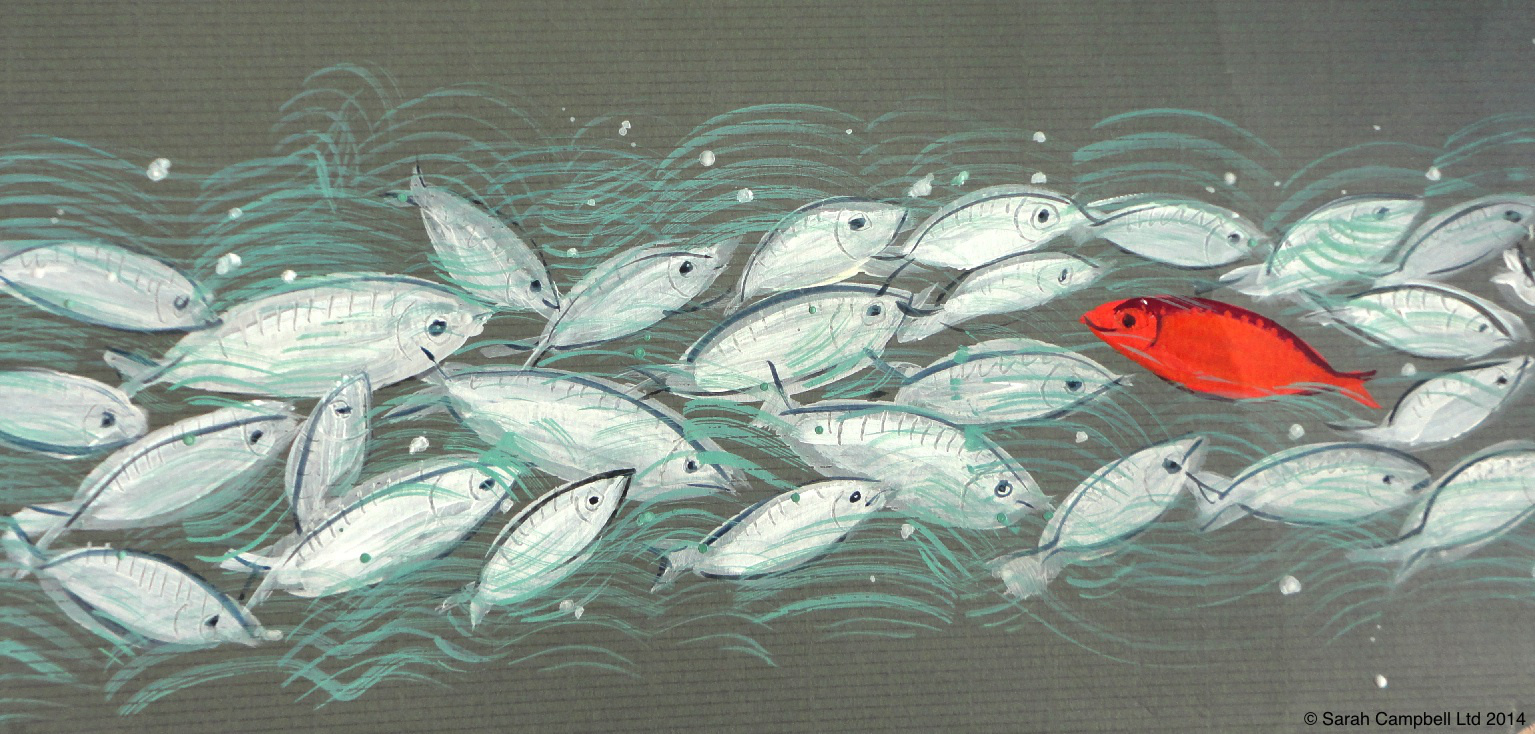
The SJW Therapy Fish:

Although it prefers to attack Whitefish & White Bass, in its mind it could beat down a Killer Whale.
Then there's the forums terror from here to Indochina, The Red Herring:

edit on 19-6-2018 by IgnoranceIsntBlisss because: (no reason given)
originally posted by: theantediluvian
a reply to: LoneCloudHopper2
Here's some more nightmare fuel. An unclassified bigfin squid recorded in 2007 at a Shell Oil drilling site. (thread here)
The video is eerie, made no less so by the green hue:
That is f#cking awesome.
Good memory!
a reply to: theantediluvian
wow.
im not sure why we want to colonize other planets when our own is still shrouded in mystery.
wow.
im not sure why we want to colonize other planets when our own is still shrouded in mystery.
Great post!That red lipped batfish threw me for a second,thought a pic of Maxine Waters got mixed in.Sorry,couldn`t resist.Seriously,though it is
truly amazing how much we still don`t know about whats living in the oceans,love articles like this one.
that bigfin squid thing reminds me of the aliens from War of the Worlds, or maybe Independence day.

this one is called an isopod. related to those roly polys we find under boards
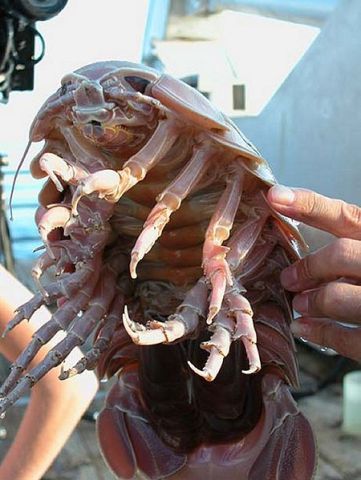

this one is called an isopod. related to those roly polys we find under boards

edit on 19-6-2018 by ElGoobero because: add pic
edit on 19-6-2018 by ElGoobero because: add pic
Bristle worms!!
I used to find them in my SW aquarium, years back.
They sifted my sand so I would let them be, until they got to about 3 inches long.
However when I broke down my SW aquarium, I found the mother of them all.
I was selling off my live rock, lifted a large piece and there he was.
The son of a bitch had to be a foot long.
I used salad tongs to pull it out.
Makes my skin crawl thinking about it.
I used to find them in my SW aquarium, years back.
They sifted my sand so I would let them be, until they got to about 3 inches long.
However when I broke down my SW aquarium, I found the mother of them all.
I was selling off my live rock, lifted a large piece and there he was.
The son of a bitch had to be a foot long.
I used salad tongs to pull it out.
Makes my skin crawl thinking about it.
a reply to: theantediluvian
That thing can go to Hell where it is surely from.
The Donaldfish is pretty cool.

That thing can go to Hell where it is surely from.
The Donaldfish is pretty cool.

originally posted by: Macenroe82
a reply to: Night Star
I should had gotten a picture of it.
It was disgusting.
I'm glad you didn't. LOL
new topics
-
A priest who sexually assaulted a sleeping man on a train has been jailed for 16 months.
Mainstream News: 1 hours ago -
The goal of UFO's/ fallen angels doesn't need to be questioned - It can be discerned
Aliens and UFOs: 1 hours ago -
Biden pardons 39 and commutes 1500 sentences…
Mainstream News: 6 hours ago -
Jan 6th truth is starting to leak out.
US Political Madness: 8 hours ago -
Deep state control - How your tax dollars are used to censor and brainwash
Propaganda Mill: 8 hours ago -
DONALD J. TRUMP - TIME's Most Extraordinary Person of the Year 2024.
Mainstream News: 8 hours ago -
Top Sci Fi/Horror Crossover Movies
Movies: 11 hours ago
top topics
-
USS Liberty - I had no idea. Candace Owen Interview
US Political Madness: 13 hours ago, 20 flags -
Jan 6th truth is starting to leak out.
US Political Madness: 8 hours ago, 19 flags -
DONALD J. TRUMP - TIME's Most Extraordinary Person of the Year 2024.
Mainstream News: 8 hours ago, 9 flags -
Magic Vaporizing Ray Gun Claim - More Proof You Can't Believe Anything Hamas Says
War On Terrorism: 12 hours ago, 8 flags -
Top Sci Fi/Horror Crossover Movies
Movies: 11 hours ago, 8 flags -
Biden pardons 39 and commutes 1500 sentences…
Mainstream News: 6 hours ago, 8 flags -
One out of every 20 Canadians Dies by Euthanasia
Medical Issues & Conspiracies: 12 hours ago, 6 flags -
Deep state control - How your tax dollars are used to censor and brainwash
Propaganda Mill: 8 hours ago, 4 flags -
The goal of UFO's/ fallen angels doesn't need to be questioned - It can be discerned
Aliens and UFOs: 1 hours ago, 2 flags -
A priest who sexually assaulted a sleeping man on a train has been jailed for 16 months.
Mainstream News: 1 hours ago, 2 flags
active topics
-
USS Liberty - I had no idea. Candace Owen Interview
US Political Madness • 29 • : fringeofthefringe -
Secretary of Defense - Lots of Attention Since Pete Hegseth was Nominated to Fill The Position.
US Political Madness • 71 • : WeMustCare -
Who's coming with me?
General Conspiracies • 43 • : BingoMcGoof -
Should be BANNED!
General Chit Chat • 18 • : worldstarcountry -
Biden pardons 39 and commutes 1500 sentences…
Mainstream News • 18 • : Euronymous2625 -
DONALD J. TRUMP - TIME's Most Extraordinary Person of the Year 2024.
Mainstream News • 23 • : stelth2 -
Magic Vaporizing Ray Gun Claim - More Proof You Can't Believe Anything Hamas Says
War On Terrorism • 11 • : worldstarcountry -
A priest who sexually assaulted a sleeping man on a train has been jailed for 16 months.
Mainstream News • 4 • : NorthOS -
The goal of UFO's/ fallen angels doesn't need to be questioned - It can be discerned
Aliens and UFOs • 3 • : TTU777 -
Drones everywhere in New Jersey
Aliens and UFOs • 85 • : bscotti
